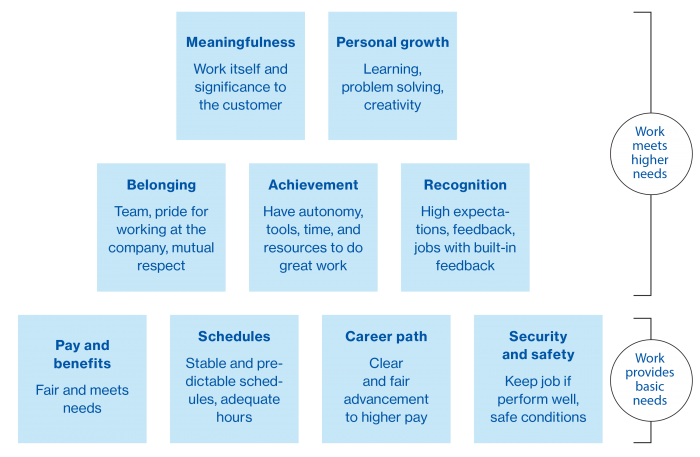Working wonders

As a doctoral student analyzing supply chain management, Zeynep Ton came across a curious phenomenon. At companies such as Borders, products would often make it to the stores but get lost inside. “They were in the wrong location, or employees couldn’t find them, or the data was inaccurate,” says Ton, now a professor of the practice at Sloan. All that confusion hurt sales and productivity. “The obvious question was: Why were operations inside stores so mediocre?”
Upon investigating, Ton found a direct correlation between stores with inventory problems and those with high turnover and inadequate staffing. As she began interviewing workers, she quickly discovered why: their jobs were miserable. “They were making close to minimum wage, they had unstable schedules, and all decisions were made at the top with no employee input,” she says. “They were just human robots. You can’t live a life like that!”
From those observations nearly two decades ago, Ton began developing the “Good Jobs Strategy,” a method to improve the jobs of frontline service workers—those who deal directly with customers—and increase company performance at the same time. Most businesses, she contends, are caught in a vicious cycle: they treat employees poorly, which in turn causes operational problems that drive down performance. “If you think that labor is just a cost to be minimized, you are going to pay as little as possible, and operate stores with as few people as possible,” she says.
That leads to high turnover, and a culture in which middle managers are putting out fires rather than focusing on long-term improvements. “Everyone seems to lose,” she says. Reversing those trends, she explains, takes more than just investing in workers. It also requires making specific choices to streamline operations and empower employees in ways that will create a virtuous cycle and help the company grow. Ton cofounded the nonprofit Good Jobs Institute in 2017 to help companies do just that by implementing the approach she outlined in her 2014 book The Good Jobs Strategy.
Growing up in Turkey, Ton saw America as a land of opportunity, a view reinforced when she earned a volleyball scholarship to attend Pennsylvania State University. “Looking at the US, we thought as long as you work hard, you will do well,” she says. But when she attended Harvard Business School after college, her research on the retail industry changed her mind. She pursued the topic for her PhD and then as a faculty member, first at HBS and, since 2011, as a professor of the practice at Sloan.

Once she’d discovered how bad retail jobs were, Ton began searching for companies that bucked the trend. She first found one in Mercadona, a Spanish supermarket chain that now has more than 1,600 stores and $24 billion in sales. The company was known for low prices and healthy profits, yet it also had industry-high wages and turnover of less than 4%. She found similar retailers in the US, including the Oklahoma-based convenience store chain QuikTrip and the grocery giants Costco and Trader Joe’s.
All of these businesses made conscious choices to improve the lives of workers. The first was to focus and simplify. Instead of carrying 40,000 products as some stores do, Mercadona has only 8,000, making it easier for employees to manage them and make knowledgeable recommendations to customers. Likewise, Costco doesn’t try to offer the widest range of products, the most convenient hours, or the prettiest store environment. Says Ton, “They do what they do best: offer high-quality products at the lowest prices.”
Second, the companies standardize rules to set clear expectations for employees—for example, at Costco all fat on meat is trimmed to a quarter-inch thick—while at the same time empowering them to make their own decisions when dealing with customers. “They are treated like human beings who don’t just have hands, but also have a brain and a heart,” Ton says. Third, workers are cross-trained so they can shift between tasks as needed. Finally, staffing is sufficient to ensure that employees aren’t constantly putting out fires: “If you go to Trader Joe’s, you’ll see there are so many people around. That gives them the ability to take care of customers and do their jobs well.”
Adopting these principles often requires a shift in culture, changing the emphasis from quantifiable short-term gains to harder-to-quantify benefits that may take time to bear fruit. For example, some companies offer lots of in-store promotions and price reductions in an effort to squeeze out more sales. However, they frequently don’t realize what havoc that wreaks on employees, who are forced to constantly change schedules or set up and take down displays at the last minute. “They are only thinking, ‘How do I maximize sales?’ But they don’t worry about the costs associated with it,” Ton says.
One company that adopted Ton’s strategy is Mud Bay, a chain of more than 50 pet supply stores in the Pacific Northwest. Back in 2014, the company paid at or below industry rates, and few employees worked more than 30 hours a week; as a result, staff turnover was almost 50% a year. That year, the company introduced profit sharing and began raising wages in 50-cent increments every six months, increasing the average hourly wage for most staff from $11.50 to $15.00. At the same time, it reduced the number of products by 15%, included staff in buying decisions, and cut store hours.
The principles that make up the Good Jobs Strategy
Companies can increase pay and performance by doing these four things.
1. Focus & simplify
Streamlining products and services allows employees to increase their productivity, reduce mistakes, and become more knowledgeable about what the company offers. This improves customer service, increases sales, and helps identify cost-saving opportunities.
2. Standardize & empower
Standardizing routine processes and setting clear expectations for performance improves employee productivity. Empowering employees to make decisions allows them to respond to customer needs—increasing customer satisfaction and sales—and also gives them opportunities to make improvements and reduce costs.
3. Cross- train
Cross-training increases job satisfaction, helps get customer needs met more quickly, and makes it possible to offer more predictable work schedules.
4. Operate with slack
Generous staffing levels reduce stress and give workers the time to do their jobs well.
While net profit margins decreased slightly over the next three years, from 2.2% to 2.0%, total sales grew by 70%, allowing the company to open more stores. Meanwhile, customer satisfaction rose, with online reviews averaging 4.8 or 4.9 on a scale of 5, and turnover fell to 31% as more employees worked full time and felt stronger ownership in the company. “We talk a lot about how cool it is to make these kinds of changes,” co-CEO Marisa Wulff told Ton’s Management of Services class this fall, “because it just makes so much sense—the whole virtuous cycle and focusing on employees and starting with people.”
After reading Ton’s book and meeting with her in 2017, John Furner, the CEO of Sam’s Club, devised a seven-part plan to empower the roughly 100,000 associates at Walmart’s $57 billion members-only retail warehouse chain. The company reduced product variety in its nearly 600 clubs by more than 25%, adopted productivity-enhancing technology, improved work schedules, and boosted pay for team leads and specialty positions from about $15 to as much as $22 per hour. Turnover decreased, and same-store sales jumped 3.0% in FY 2018 and 5.5% in FY 2019. (Furner has since become CEO of Walmart US.)
In the two years since Ton cofounded the Good Jobs Institute with Roger Martin, former dean of Toronto’s Rotman School of Management, the institute has helped 10 companies of various sizes adopt her strategies. And in the past five years, Ton has shared her research in workshops with C-suite executives at over a dozen large companies that collectively employ more than 2.5 million Americans. Most of the executives were surprised to learn just how miserable and chaotic many of their employees’ jobs are. “I haven’t yet seen an executive who hasn’t been moved by it,” Ton says. “Nobody wants to offer bad jobs.”
Executives often respond positively to the business case as well, says Ton; in fact, those she worked with have already improved schedules and raised wages for nearly 1.5 million workers at their companies. However, it can be difficult for these operational changes to gain traction when CEOs are weighing “sexier” improvement strategies such as acquisitions and new technologies like artificial intelligence—even though they aren’t mutually exclusive. “They say, ‘This seems like really hard work, and by the way, investors are not asking me about employee turnover,’” she says. Ton also sees ongoing prejudice by some executives against customer service workers, citing one Fortune 50 CEO who told her, “We provide high enough wages for people with those skills.”
But as the American economy grows increasingly polarized, Ton says, it is essential that we rethink the worth of retail and service employees—and see them not as a cost, but as a resource to power our economy. “We want to show that these jobs can have meaning and dignity,” she says. “Offering good jobs is a choice anyone can make.”
Keep Reading
Most Popular
Large language models can do jaw-dropping things. But nobody knows exactly why.
And that's a problem. Figuring it out is one of the biggest scientific puzzles of our time and a crucial step towards controlling more powerful future models.
The problem with plug-in hybrids? Their drivers.
Plug-in hybrids are often sold as a transition to EVs, but new data from Europe shows we’re still underestimating the emissions they produce.
Google DeepMind’s new generative model makes Super Mario–like games from scratch
Genie learns how to control games by watching hours and hours of video. It could help train next-gen robots too.
How scientists traced a mysterious covid case back to six toilets
When wastewater surveillance turns into a hunt for a single infected individual, the ethics get tricky.
Stay connected
Get the latest updates from
MIT Technology Review
Discover special offers, top stories, upcoming events, and more.